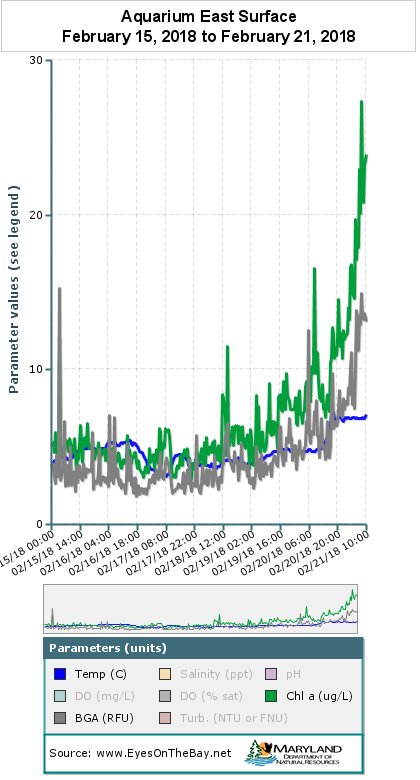Algae blooms happening more often in more places, and sometimes later in the year than typical. Some algae produce toxins that result in massive fish kills, affecting us and our environment. Baltimore Harbor Watchman Al Place will be keeping an eye on all waters and offering insight about blooms, their impact, and how an Imaging Flow Cytobot could have helped.
Toxic species found in some Bay waters
The Capital Gazette is reporting that algae blooms are already clouding Chesapeake Bay waters, including one that is running the length of Severn River.
The species most in abundance in these algae blooms, called mahogany tides for the discoloring of the water, Prorocentrum minimum, a toxic species common in cold temperate brackish waters. It can contribute to dead zones as the bloom dies and sucks oxygen out of the water column, and in high enough volumes, it could also cause a fish kill.
The Maryland Department of the Environment received samples from tides reported in Pocahontas and Church creeks. According to the article, the department reported Pocahontas Creek “contained a very large bloom with 104,040 cells per milliliter.” The sample also contained 1,010 cells per milliliter of Karlodinium veneficum, a more toxic species.
A different player in town
As temperatures warmed around the harbor last week, a different player bloomed in the Baltimore's harbor: Apedinella radians.

A swell and a knockout
As 2017 was rolling to an end, the Baltimore Harbor saw another algae bloom.
Around December 19, chlorophyll levels had come down some in the open waters near the National Aquarium, but were still high in the channel between piers 3 and 4 on the eastern side of the Inner Harbor, according to reports on Eyes on the Bay, a Maryland Department of Natural Resources-run program that shows continuous monitoring data. The result was a mahogany tide, the second in recent weeks despite an atypical time of year for blooms.
During the next week, chlorophyll and blue-green levels increased again in Baltimore Harbor, but cold temperatures knocked levels back down after two days and by the end of the day on Christmas, all was calm.
We need to put a face to the water color.
Is a fish kill coming in Middle River?
While Harbor Watchman, Al Place, was hosting a conference on harmful algae, there was an algae bloom in Maryland’s Middle River.
The toxic algae Karlodinium veneficum was present in the samples Harbor Watchwoman Jen Wolney collected.
Similar blooms have taken place this time in previous years, including a bloom that killed 201,789 fish in November 2015 in Middle River. In December 2016, Maryland Department of the Environment had investigated a large fish kill involving 20,553 fish in the upper tidal Gunpowder and Bird rivers near Joppatowne (Harford/Baltimore Counties). In both cases, Karlotoxin was at least one of the causes of the fish kill. Karlotoxin attacks the gills of the fish.
Place and Wolney were among the team of researchers to publish an abstract given at the 9th US Symposium on Harmful Algae about Karlotoxin causing unusual “cold weather” fish kills in Maryland. Charles Poukish was the paper’s lead author.
K. veneficum normally blooms in summer or fall. In the case of the December 2016 fish kill, researchers found while feeding on cryptophytes, K. veneficum was following a salt wedge into the freshwater reaches of the bay well into mid-December when water temperature had fallen to below 33 degrees.
“As a consequence, freshwater fish were trapped between a gill-damaging algal species and the salt wedge," they wrote in the abstract. "These fish were subjected to a lethal one-two punch to gill function induced by a combination of karlotoxin and salinity stress.”
What’s the bottom line?
K. veneficum was found in Baltimore's Inner Harbor in 2005 and has been detected in the region every year since then. Daily monitoring of the cell concentrations of K. veneficum and the abundance of its favorite food, Cryptomonas, can help scientists predict when toxin will be produced and where fish kills may occur. Daily monitoring will also help scientists monitor for other algae species, such as Dinophysis and Alexandrium, which are toxic at lower concentrations that are harder for scientists to detect with traditional methods.
Place says if IMET had an Imaging Flow Cytobot, he would be able to let everyone know what’s in the water before a fish kill can occur.
“We need to put a face to the water color,” he said.
Unusually timed algae bloom reported in Baltimore harbor
The Baltimore Sun reported on Friday, Dec. 1, 2017 about a “mahogany tide” of algae, including one species known to cause fish kills, appearing in the Baltimore harbor.
The algae bloom is an unusual occurrence at this time of year when waters are cool. Monitoring equipment showed an explosion of chlorophyll, the molecule plants use to turn sunlight into energy, in waters near the National Aquarium on Thursday, reporter Scott Dance wrote. He interviewed Harbor Watchman Al Place, a professer and researcher for the University of Maryland Center for Environmental Science's Institute of Marine & Environmental Technology in Baltimore.
Tests revealed two types of algae, Place said — one known for its brown color, and the other for emitting toxins.
“What the effects are going to be depends on the persistence” of the bloom, Allen said. “My guess is that the fish in the harbor can avoid it.”
CBS Baltimore, WJZ-13, interviewed Place on Dec. 5 about the cause of the browned water.
“Water temperatures are a little bit up, relative to what they usually are. There are always sufficient nutrients in the bay for it to bloom,” Place told Alex DeMetrick.

